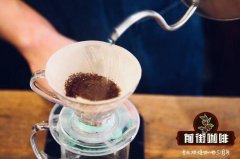A brief introduction to the characteristics of Ugandan Coffee producing areas in Africa how to brew and share Ugandan coffee

Professional coffee knowledge exchange more coffee bean information please follow the coffee workshop (Wechat official account cafe_style)
Qianjie Coffee-Uganda Coffee production area characteristics, hand-brewing sharing, tasting
Uganda is located at the source of the Nile, a landlocked country not off the sea in Africa. Although it has a long history of producing coffee like other East African countries, the quality of coffee has never been improved because of the war caused by ethnic antagonism. Most of the good coffee here is grown in areas adjacent to Kenya, and some good coffee beans are shipped to Kenya to be sold as Kenyan coffee, and Uganda did not leap into a fast-growing country until the war stopped 15 years ago.
Uganda has dense green forests, lakes, wetlands and rich rivers. Coffee is the largest crop in Uganda. About 500000 coffee farms are engaged in coffee-related agriculture, accounting for 25% of the total population. Coffee trees are mostly robusta coffee trees, which account for about 94% of coffee cultivation in Uganda, and only 6% are traditional Arabica trees. These rare coffee beans grow in tropical rain forests, and most of them are exported to countries around the world.
The Mt Rwenzori Mountains, known as the "Mountains of the Moon", are located in western Uganda and are the border between Uganda and the Democratic Republic of the Congo (DRC). Coffee is Uganda's main cash crop, accounting for 95% of Uganda's total exports.
The local Bukonzo people live in these mountains and have been farming in this area for hundreds of years. The mountain area has fertile soil and good climatic conditions, which is very suitable for coffee cultivation.
Brewing and sharing
Recommended cooking method: hand flushing
Filter cup: V60
Water temperature: 90 ℃
Powder / water ratio: 1:15
Degree of grinding: medium and fine grinding, that is, the thickness of fine sugar (BG 5R: 57% pass rate of Chinese standard No. 20 screen)
Flushing and cooking technique: segmented extraction. Steam with 35 grams of water for 25 seconds, circle water injection to 130 grams, continue water injection to 227 grams when the water level is about to be exposed, and remove the filter cup when the water level is about to expose the powder bed. (the time of steaming starts) the extraction time is 1: 39: 50 ".
Flavor: it smells with a hint of fermented aroma, with cocoa, cream, peanuts and soft acid.
Taste refers to the taste of the tongue. There are no more than four flavors of coffee: sour, sweet, bitter and salty (some people think there is a fresh description). When you sip coffee, each taste may be different, sometimes sour and sometimes bitter, because the amount of coffee is too small to cover the entire tongue (different areas of the tongue have different sensitivity to each taste).
Both sour and bitter are easily perceived tastes, because everyone has different degrees of taste acceptance, and the degree of bitterness within their own acceptable range can be said to be good (but others may not necessarily agree).
In addition to the degree, it is the kind of sour or bitter, such as rotten taste of sour, carbonized bitter, are not people's favorite kind, as long as there is a little bit, this cup of coffee will be seriously deducted points. Of course, some people think these tastes good, depending on the taste preference of the individual.
Relatively speaking, although the taste of sweetness is a primitive desire, it is somewhat difficult to perceive in coffee, and it is difficult to judge by taste alone. It is usually assisted by the aroma of ketones and aldehydes in the flavor.
Judging from the taste alone, sour (obviously but not irritating) > bitter (existing but not prominent) > sweet (as much as possible) is a good cup of coffee. When you drink coffee, the senses of taste, touch and smell all activate, so when you can't feel the taste alone, try to stop breathing through your nose (or gently cover your nose with your fingers). At this time, the taste of coffee in the mouth is "isolated".
Taste
To put it simply, the taste is the touch of coffee liquid as it passes through the tongue, the so-called mellow thickness. The complexity of taste: the existence of many unobtrusive flavors mixed together will give people a mellow and fragrant feeling. For example, chocolate, marmalade, yogurt, nut jam and so on are added to curry. Taste persistence: the longer the aftertaste remains in the mouth, the stronger the mellow feeling, the most obvious is the bitterness in the mouth.
Delicate texture: coffee contains colloid and other particles (proteins or lipids and other tiny particles) caused by the sticky taste and make people feel mellow. If the taste of coffee in the mouth is very different from that after swallowing, it will feel profound (a combination of complexity and persistence), and it will also feel mellow.
Smoothness: smoothness is, in popular terms, good or bad liquidity, so I won't repeat it here.
Flavor
After we taste the coffee, we should not only say that the coffee is delicious, but also say where the coffee is delicious. With a sour taste like lemon and a fragrance like milk sugar, these words can well describe the taste of coffee.
END
Important Notice :
前街咖啡 FrontStreet Coffee has moved to new addredd:
FrontStreet Coffee Address: 315,Donghua East Road,GuangZhou
Tel:020 38364473
- Prev

Introduction of Ugandan coffee beans A brief introduction to the taste characteristics of Ugandan coffee seed treatment
Professional coffee knowledge exchange more coffee bean information please follow the coffee workshop (Wechat official account cafe_style) front street coffee-Ugandan coffee varieties, treatments, characteristics introduction Uganda, located in east-central Africa in the Great Lakes region, almost the whole territory on the East African Plateau, Churchill praised it as the Pearl of Africa. But Uganda doesn't do it at all, far from what we've solidified.
- Next

Brief introduction of Panamanian coffee bean producing areas
Professional coffee knowledge exchange more coffee bean information please follow the coffee workshop (Wechat official account cafe_style) Front Street Coffee-Panamanian Coffee region introduction Panama has been one of the best coffee producers in the world since three years ago. Panama Coffee is mainly produced in the west near the border with Costa Rica and produces excellent washed coffee. Compared with species at middle and low elevations
Related
- Beginners will see the "Coffee pull flower" guide!
- What is the difference between ice blog purified milk and ordinary milk coffee?
- Why is the Philippines the largest producer of crops in Liberia?
- For coffee extraction, should the fine powder be retained?
- How does extracted espresso fill pressed powder? How much strength does it take to press the powder?
- How to make jasmine cold extract coffee? Is the jasmine + latte good?
- Will this little toy really make the coffee taste better? How does Lily Drip affect coffee extraction?
- Will the action of slapping the filter cup also affect coffee extraction?
- What's the difference between powder-to-water ratio and powder-to-liquid ratio?
- What is the Ethiopian local species? What does it have to do with Heirloom native species?

